With energy efficiency awareness growing, and new lighting technologies being developed at a rapid pace, which bulbs on the market offer the best value for the eco-conscious? With the more recent popularization of Compact Fluorescent Light (CFL) bulbs due partly to their electricity savings and partly from huge discounts and government energy rebates making them more affordable, we ask the questions: which is the best value, which has the best life, which is the most eco-friendly, and which puts off the best light? We set out to put them all to the test.
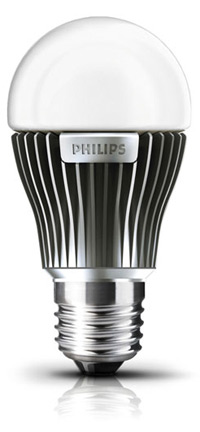 Light Emitting Diode (LED)
Light Emitting Diode (LED)
Growing LED technology is developing one of the most energy efficient, long lasting and versatile bulbs in history. Already replacing traditionally incandescent automotive bulbs, flashlight bulbs, monitors and televisions, the LED is quickly becoming the new standard in eco-friendly efficient lighting. Household and commercial light bulbs are still in their infancy with very few and very expensive offerings that for the most part cannot compete with current bulb offerings.
Average Lifespan: 60,000 hours
Energy Consumption: 230 lumens / 7 watts = 33.9 lumens/watt
Average Bulb Cost: $54.00
Pros:
- Cool to the touch
- Available in several shades and colors
- Dimmable
- Very high color spectrum or temperature (closely mimics daylight) at 4200k
- Extremely long life
- good for floodlights and direct, focused lighting
Cons:
- Price and availability
- narrow focus of directed light (almost like a flashlight in many instances)
- still in early stages of development for home lighting applications
Best Bet: Use in as low output uses such as nightlights, accent lighting and for directed and focused lighting situations, especially in difficult to replace areas
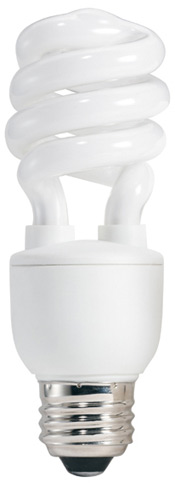 Compact Fluorescent Light (CFL)
Compact Fluorescent Light (CFL)
Revolutionizing the light bulb industry a few years ago with the development of a compact, bulb size fluorescent bulb prompted huge gains in efficiency and longevity of lights for household use. Troubled by flickering, cold starts, and harsh color temperatures, and lack of dimmability, the newer generations of CFL bulbs have solved many of these problems to become the most popular energy efficient replacement bulb (government rebates and offers have also helped).
Average Lifespan: 10,000 hours
Energy Consumption: 850 lumens / 14 watts = 60.7 lumens/watt
Average Bulb Cost: $2.98
Pros:
- Available in many color spectrums and can mimic daylight easier
- Currently best value for initial cost over energy efficiency savings.
Cons:
- Contains Mercury, a toxic heavy metal which can pollute water sources if disposed of incorrectly
- Lighting can be harsh when compared to the softer glow of an incandescent
- Some older models have difficulty outdoors or in cold temperatures, flickering issues and problems with dimmer switches.
Best Bet: As a general use bulb in most common situations
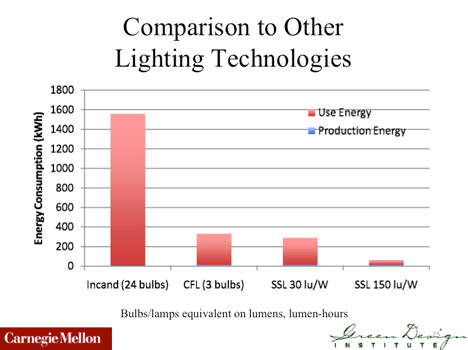
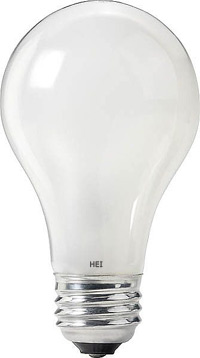 High-Efficiency Incandescent (HEI)
High-Efficiency Incandescent (HEI)
Tough new efficiency standards, due to take effect in 2012, are changing the lighting business. No traditional incandescent bulb on the market would be able to pass these energy standards prompting a new surge of competition among lighting manufacturers who have relied on the standard centuries-old technology developed by Thomas Edison. A new entry to the energy efficiency race, high-efficiency incandescent (HEI) bulbs are in development to compete with CFL bulbs and pass these new standards boasting four times the energy savings over the traditional incandescent.
Average Lifespan: TBD (estimated )
Average Output: TBD (30 lumens/watt target output)
Average Cost: TBD (estimated at $5 a bulb)
Pros:
-
Can be used in all existing lighting applications
Longer life than original filament bulbs
Lower heat output than original filament bulbs
Cons:
- Still in development
- Not quite as energy efficient as CFL or LED
Best Bet: For use when an incandescent bulb is necessary for the lighting application.
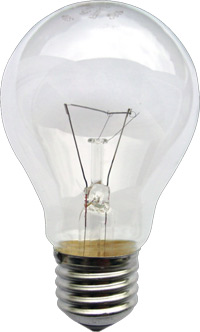 Original Incandescent (filament bulbs)
Original Incandescent (filament bulbs)
Not much has changed in the original design of your basic incandescent filament bulb. Advances have been in the area of light output, usually at the cost of efficiency. Halogen bulbs are perhaps the most recognizable as they can be extremely bright, however, many were shocked at their electric bills after using these bulbs. Given the age of the technology, production is cheap and plenty with the average cost of a basic tungsten filament bulb at $1.34.
Average Lifespan: 1,500 hours
Energy Consumption: 850 lumens / 60 watts = 14.5 lumens/watt
Average Bulb Cost: $1.34
Pros:
- Inexpensive and common
- Soft lighting
Cons:
- Least efficient with a lot of the energy released as heat (think: easy bake ovens)
- Short lifespan
Best Bet:
Use in specialized situations, easy to replace and rare use applications to keep energy costs low
Bottom line, if you need to replace your bulbs now, choose a quality CFL bulb for the best energy savings and longevity, just make sure to dispose of it correctly. LED and HEI technologies are developing rapidly, so if you already have an energy efficient bulb in place, you may want to wait before stocking up your storeroom or closet with replacements. Replacing your current incandescent bulbs can result in an immediate savings on your electric bill (especially when multiple bulbs are replaced in high use areas), and will greatly increase your energy efficiency.
Comments 12
The figures for the LED lamp are wrong.
It generates 230 Lumens @ 7 watts at a colour temperature of 4200K which is a daylight white (i.e. will look blue indoors).
This equates to approx 33 L/watt, not 141.6 as suggested, or one fifth the efficiency you quote.
Here is a reference
http://www.dotlight.de/products/en/Illuminants/LED/Socket-E27/High-Power-LEDs/Philips-MASTER-LED-E27-7W-white.html
If you want energy efficiency, get CFLs, unless you want to dim them, or switch them on and off rapidly.
In a couple of years, LEDs may get there, but they are a long way off + their cost per lumen is off the scale.
Author
@James Mahon
Thanks for the correction! My original calculations were based on potential output for optimal LED technologies which have not been developed yet (although i unfortunately did not note that). I have updated the post to reflect those correct figures. Lets hope they do make it there someday soon.
-JP
With energy efficiency awareness growing, and new lighting technologies being developed at and the more recent popularization of Compact Fluorescent Light (CFL) bulbs due partly to their electricity savings and partly from huge discounts and government energy rebates making them more affordable.
I really like the new LED bulbs we’re seeing. I’m optimistic that we will see the same trend in cost as we did for the decorator string lights. A few years ago they were VERY expensive compared to traditional string lights. Now they are about the same cost and use about 1/10th the electricity.
Kim
Hi, Here is Nail from Shenzhen Greenergy Lighting Co,ltd that is a professional manufacturer which specializes in LED lighting products located in Shenzhen China.
i hope we can do some businness on LED products.
Our products range from
1, LED Tube, LEd Bulb, LED Street Light, LED flood light, LED display, LED strip,Led grow light, LEd underwater/ground light, LEd flash light,
2, LEd components: Throught hole LED, Super flux ELD, SMD LED
Kindly let us know if you need samples, you would be impressed by our quality.
Looking forward to your early reply
Nail Wong
ShenZhen Greenergy lighting Co.,Ltd
ADD:Building 1, Fuyuan industry Park,Qiaohe Road, Fuyong town,Shenzhen City,China
Tel:86-15899876563 , 86-755-29923356
http://www.G-lighting.com
Email/msn:ledjackkg@hotmail.com
Skype:Nail00011
Hi
Great article!
Was wondering how the Average Lifespan of a LED bulb changes when the voltage varies?
Established in 2000, we, Shiny Lighting Co., Ltd, are a professional manufacturer of LED Products, such as decorative LED strip, LED bulbs, LED tubes , automotive LED lamps, LED flashlight, etc.
We are professional LED Tube, LED Light Bulbs and LED Strip Manufacturer in China Shenzhen. And for all the LED Lights, OEM and ODM Service is available.
I agree with the cons of LED bulbs, so led table lamps is quite a good idea for led bulb application.
However, as the LED technologies developing, as well as the price decline, would not doubt that in a few years later, led bulbs could be used widely in home lighting applications.
I rarely drop comments, however I looked through some remarks on
CFL and LED Light Bulb Energy Savings | The Chic Ecologist.
I actually do have 2 questions for you if it’s allright.
Could it be simply me or does it look like like a few of these responses look
as if they are left by brain dead individuals?
😛 And, if you are writing at other places, I would like
to keep up with anything fresh you have to post. Could you post
a list of all of your shared sites like your Facebook
page, twitter feed, or linkedin profile?
@James Mahon
Who are you? Also where the F do you get your information and knowledge from? Maybe you don’t want to change with the times or something because you are factually wrong.
Every site and brightness comparison and power comparison/lumen etc have LED lights more efficient than CFL’s.
LED’s would not be taking over the market or even becoming remotely popular if they were a step backward in efficiency you fool.
Also unlike CFL’s, White LED’s release virtually all their light in the visible spectrum.
That is something you of course will probably deny also. But light measurements have been taken from them and it’s not rocket science. They produce virtually no IR or UV light. Unless of course they are LED’s designed for that. Normal white LED’s don’t produce IR or UV light which again makes them more efficient than other lighting techniques.
Also if you are secretely correct that LED’s are behind CFL’s then I guess there is a huge global conspiracy keeping the covers over that fact since all the companies print clearly on their lights the output which shows them to be at least slightly more efficient than CFL’s and all the comparison sites and pictures show LED’s to be at least slightly brighter per watt than CFL’s.
I am also not sure what you are on about claiming they are really expensive? Where are you buying them from?
They are cheap as bloody anything. You can buy 100 5mm LED’s for $1.
You can buy 1W diodes in packs of 10 for like $3.
You can buy a whole light for only $2.
They are far from expensive.
You are not factually right in anything you said in fact. It’s quite sad how people somehow don’t point this out to you.